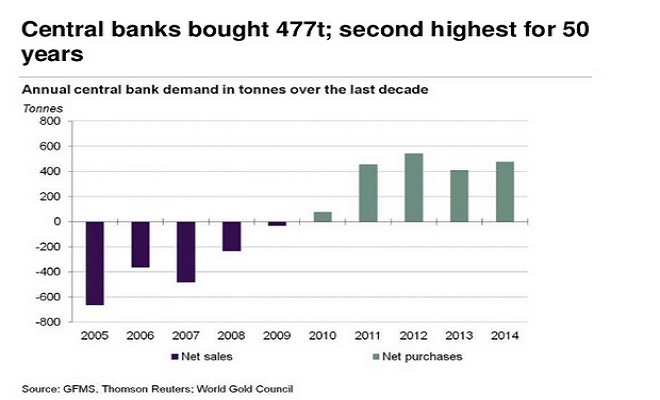The Euro zone raised its gold holdings by 7.437 tonnes to 10,791.885 tonnes in January, International Monetary Fund data released overnight showed.
The rise in gold holdings was small in tonnage terms and in percentage terms – especially when viewed in the light of the recently launched ECB’s EUR 1 trillion QE monetary experiment.
Nevertheless, the rise in Euro-area gold holdings shows how the ECB continue to view gold as an important monetary asset. Mario Draghi said of gold in October 2013 that gold is a “reserve of safety” that “gives you a value-protection against fluctuations against the dollar.”
Draghi told an open forum at Harvard’s Kennedy School of Government, why central banks want gold and what value it offers. He said that there were “several reasons” to own gold including “risk diversification”.The increase in reserves came at a time, January, of rising gold prices amidst the reemergence of the Greek debt crisis.
It may signal that the ECB and Eurozone are set to embark on a gold accumulation programme. More likely, it is simply a way to bolster confidence in the euro due to increasing doubts about the viability of the single currency.
Russia sold a very small amount of gold in January for the first time since March. Russia lowered its reserves to 1,207.7 tons from 1,208.2 tons, ending nine months of consecutive purchases, the IMF data showed.
Russia, the world’s fifth-biggest gold holder, had been adding to its holdings for many years in order to bolster the rouble.
Before last month, Russia had bought at least 18 tons a month since September and more than tripled its holdings since 2005.
Turkey’s gold reserves fell marginally last month along with Mexico and Belarus, the data showed.
Kazakhstan increased gold reserves for the 28th straight month, while Ukraine added to holdings for the first time since August, the data showed. Kazakhstan boosted holdings to about 193.5 metric tons from 191.8 tons a month earlier as Ukraine’s rose to 23.9 tons from 23.6 metric tons.
Kazakhstan’s hoard rose 33 percent in the past year alone and more than doubled in the past three years.
Ukraine’s assets dropped in November to the lowest level since 2005 as its foreign currency reserves contracted and the hryvnia slumped amid the conflict and collapsing economy. There were also concerns that the newly installed government had acquired the gold and moved it offshore, out of Ukraine.
Central banks are some of the largest buyers of gold today – see table above. Central banks have been adding to their gold reserves for the past five years, a reversal from two decades of selling since the late 1980s. They were net buyers in 2014 and are set to be net buyers again 2015.















